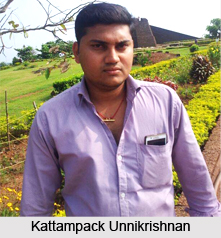 Sri Kattampack Unnikrishnan is one of the most promising young performers of Mudiyettu, Kerala"s traditional ritual theatre and folk dance drama enacting the mythological tale of the battle between Goddess Bhadrakali and the demon brothers Daarika and Daanavendra. From starting off with portraying minor roles of Shiva and Narada, he today puts on the lead character of Bhadrakali in Mudiyettu enactments.
Sri Kattampack Unnikrishnan is one of the most promising young performers of Mudiyettu, Kerala"s traditional ritual theatre and folk dance drama enacting the mythological tale of the battle between Goddess Bhadrakali and the demon brothers Daarika and Daanavendra. From starting off with portraying minor roles of Shiva and Narada, he today puts on the lead character of Bhadrakali in Mudiyettu enactments.
Early Life and Training of Kattampack Unnikrishnan
Sri Kattampack Unnikrishnan was born on May 31, 1990, in the small village of Kattampack in Neezhoor, in the Kottayam district of Kerala. He completed his education from various schools in Vadakkenirappu, Neezhoor and Kurichithanam in the state. He had a strong inclination towards the ritual art of Mudiyettu from his childhood days. He met a boy who was going to attend the ritual, went with him and eventually ended up as a performer in the same, having begun learning the art form at the age of 12. Unnikrishnan was trained under Sri Thirumarayur Vijayan Marar, an exponent of the art form, under the Guru-Shishya tradition of learning.
Contribution of Kattampack Unnikrishnan to Mudiyettu
With tremendous effort and dedication of 15 years, Kattampack Unnikrishnan has mastered the art form of Mudiyettu. From playing relatively smaller roles like Sage Narada and Lord Shiva in its enactment, Unnikrishnan now dons the main character of Bhadrakali. He performs Mudiyettu enactments along with his troupe, Sree Bhadra Mudiyettu Sangham based at Thirumarayoor. His proficiency over the art has got him the good fortune of working with the masters of this art and also learn from them.
Mudiyettu being on the verge of extinction like many other traditional art forms, Sri Kattampack Unnikrishnan is trying his best to keep the tradition alive. He has an evolved style of his own and performed in temples, tourism festivals and schools and colleges across the length and breadth of Kerala. He is of the opinion that the ancient Mudiyettu art form which has found a place in UNESCO"s Representative List of Intangible Cultural Heritage of Humanity should be given more importance by the government and the folk arts academies.
This article is a stub. You can enrich by adding more information to it. Send your Write Up to content@indianetzone.com
Related Articles:
Mudiyettu, Kerala Ritual Theatre
Forms of Indian Theatre
Kerala
Folk Theatre of Kerala
Ritual Theatre in India
Goddess Bhadrakali
Performance of Mudiyettu
Costumes and Make up in Mudiyettu
Comic Relief in Mudiyettu
Pazhoor Kunju Kunjan Marar
Varanattu Sankara Narayana Kurup
Classical Indian Dance Drama
Lord Shiva
Narada, Divine Sage
Gurukulam Tradition in India




















